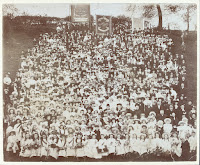At Cheshire Archives, we are just beginning to explore the wealth of incredible material found within Parkside’s case books. Technology is supporting the information shift from these original leather-bound books into a searchable, accessible on-line research goldmine. With that transformation, our insight into the lives of those living within its walls magnifies and we start to gather information beyond the medical…These patients were real people, with real lives, in a time when we were just learning about mental health.
Where did they come from?
Parkside Asylum was in Macclesfield; however, its patients came from all over the United Kingdom. The case books are an incredible source of address and place information, which helps us delve even further and join the dots with sources already available to us – censuses, births, marriages and deaths indexes, electoral registers.
What did they do before they came to Parkside?
The occupations of the Parkside patients are incredibly diverse – from actresses to accountants, cloggers to cooks, shepherds to schoolmasters, paupers, and private patients alike. Parkside treated patients from every walk of life.
Could these be the only images of your ancestors?
The casebooks contain small passport-sized images of many of the patients. Putting a face to a name and their story. An interesting observation is although there are a few from the 1870’s, these photographs are generally much more common during the 1880’s onwards.
Happenstance or hereditary…
The detailed case notes, medical terms and diagnoses of Parkside’s patients will help us to better understand mental illness and its treatment in the 19th century. Why were patients admitted? How were they treated? What was their diagnosis? Some patients were admitted many, many times. Can we find out why? Although some died at the Asylum, others were discharged, some were transferred to other asylums or hospitals. With the right connections, perhaps one day we can build a timeline of what happened to them. After all, wouldn’t you want to know what happened to your great Aunt or great-great Grandmother?
The use of different sources, like the census, comes in handy as interpreting the copperplate writing from the original books is sometimes a challenge! Were they a Boden, Bowden, or Bodan? Is that a T, a J, or an S – occupation Tailor, Jailor, or a Sailor?
Prepare to be shocked…there was no holding back with how medics described their patients in the 1870’s. Some of the terminology used then, we certainly wouldn’t use now. Medical terms and names of diseases are vast and varied. Do you know what Mania a potu is, for example?
We have 40 years of detailed case books and - with the help of our amazing volunteers – we will continue to build and develop this incredibly valuable information source for us all.
So, you see, the patients of Parkside Lunatic Asylum are not just names on a page, and we’re starting to tell their stories…
The use of different sources, like the census, comes in handy as interpreting the copperplate writing from the original books is sometimes a challenge! Were they a Boden, Bowden, or Bodan? Is that a T, a J, or an S – occupation Tailor, Jailor, or a Sailor?
Prepare to be shocked…there was no holding back with how medics described their patients in the 1870’s. Some of the terminology used then, we certainly wouldn’t use now. Medical terms and names of diseases are vast and varied. Do you know what Mania a potu is, for example?
We have 40 years of detailed case books and - with the help of our amazing volunteers – we will continue to build and develop this incredibly valuable information source for us all.
So, you see, the patients of Parkside Lunatic Asylum are not just names on a page, and we’re starting to tell their stories…
Our team of remote volunteers are helping Cheshire Archives index
the Parkside case notes. This means the data can easily be searched and
analysed by the public and researchers alike.
Want to be a part of it? You can! Email us for more
information or join up straight away on the Zooniverse
website

















